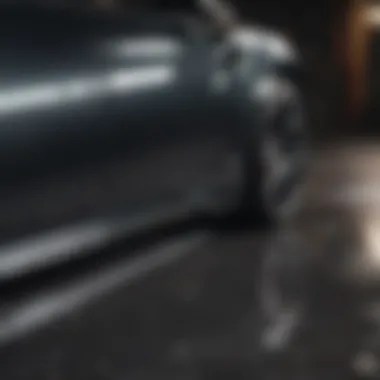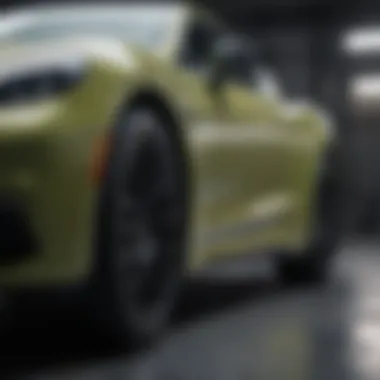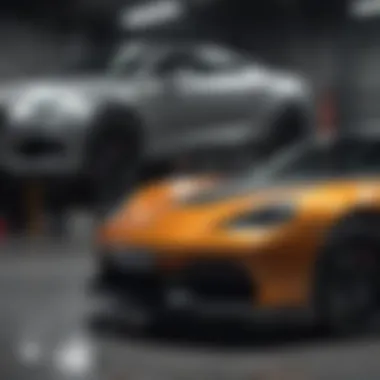In-Depth Guide to Innovative Car Paint Protection Options


Intro
In the ever-evolving world of automotive care, the significance of paint protection cannot be overstated. For car enthusiasts and everyday drivers alike, preserving the appearance of their vehicles plays a crucial role in maintaining both aesthetic appeal and resale value. The market is flooded with a variety of paint protection options that promise to keep your ride looking sharp. This exploration dives into the intricate realm of car paint protection, offering an extensive review of the choices available today.
The Importance of Paint Protection
Protecting a vehicle's exterior goes beyond just shining it up for a show; it's about shielding your investment from environmental factors such as UV rays, road debris, and harsh weather. These threats can dull the finish and lead to costly repairs. By employing effective paint protection strategies, car owners can extend the life of their paint job and retain the vehicle's original allure.
In the sections that follow, we will break down various paint protection products, their benefits, and user experiences. We'll also delve into technologies that enhance paint durability, aiming to arm potential buyers with the knowledge necessary to make informed decisions.
Key Points We Will Discuss
- Evaluation of different brands and products
- Application methods and the processes involved
- Insights from users and independent tests
- Durability assessments and long-term effectiveness
- Tips for maintaining paint protection systems and maximizing their longevity
With this understanding, let's gear up for a detailed look into the latest and greatest paint protection innovations that promise to keep your car's exterior as pristine as the day you drove it off the lot.
Intro to Car Paint Protection
Car paint protection is not just a fancy accessory; it’s a genuine necessity in today’s world of automotive care. This section offers an in-depth look at the significance of safeguarding your vehicle’s paintwork. Every time you drive, your car is exposed to an array of elements such as UV rays, road salt, dirt, and debris. Without proper protection, these factors can lead to paint deterioration, which not only affects the vehicle's appearance but also its resale value.
Importance of Paint Protection
Protecting the paint on your car is akin to putting a good umbrella over your head during a rainstorm. With countless challenges lurking around every corner, such as scratches, fading, and contamination, having a protective layer can effectively act as a barrier. Here are some compelling reasons why investing in paint protection is important:
- Aesthetic Appeal: A shiny, well-maintained exterior gives your car a showroom appearance. Paint protection keeps that gloss intact and makes washing easier.
- Retention of Value: Cars typically depreciate quickly, but those that are well cared for retain more value in the long run. A car with a pristine paint job is more appealing to potential buyers.
- Damage Prevention: It not only protects against natural elements but also minimizes risks from car washes, or debris in parking lots.
"An ounce of prevention is worth a pound of cure." This old adage rings especially true for maintaining the beauty and integrity of your car's surface.
Overview of Available Options
When it comes to paint protection, the market is brimming with options that cater to various needs, budgets, and preferences. It’s like choosing a drink at a café; there’s something for everyone, and knowing your choices can be half the battle. Here’s an overview of the main types of paint protection available:
- Protective Coatings: These are synthetic, adhere to the vehicle’s surface, and form a protective barrier against contaminants.
- Ceramic Coatings: Renowned for their durable nature, these coatings bond with the car's paint and offer superior protection against the elements and help in easy clean-up.
- Sealants: They provide a durable layer of protection, often enriched with polymers, and can last longer than regular wax, making them ideal for those looking for longevity.
- Waxes: Though more traditional, they still have their place. Wax provides a shiny look but generally requires more frequent applications.
Understanding these options can help drivers make informed decisions that suit their specific preferences and circumstances. All in all, identifying the right solution is essential for those looking to enhance the longevity and appearance of their vehicles.
Types of Paint Protection Products
In the realm of car maintenance, understanding the various types of paint protection products is crucial for any car owner looking to safeguard their investment. Each option comes with its own unique attributes, advantages, and some considerations to keep in mind. Knowing these differences can lead to making a more informed decision tailored to specific needs, environment, and budget.
Protective Coatings
Protective coatings function as a shield against a host of potential threats—some common culprits include dirt, bird droppings, and environmental pollutants. These coatings work by forming a transparent layer on top of the car's original paint, effectively acting as a barrier. Not only do they preserve the aesthetic appeal, but they can also simplify washing and maintenance.
- Easy to Apply: Many of these coatings can be applied without professional help, making them accessible for DIY enthusiasts.
- Longevity: Some products boast durability lasting from several months up to years.
However, proper surface preparation is critical before application, lest any dust or unevenness spoil the final outcome. At times, these coatings can feel pricy upfront, but consider it an investment—one that keeps your vehicle looking fresher for longer.
Ceramic Coatings
In the upper echelon of paint protection, ceramic coatings reign supreme. They chemically bond with the vehicle's paint, creating a tough layer that promises longevity and resistance to wear and tear. For car enthusiasts and those wanting maximum protection, ceramic coatings present a benchmark.
- Hydrophobic Properties: Rainwater beads off easily, reducing water spots and dirt accumulation.
- Scratch Resistance: These coatings offer enhanced defense against minor scratches and the typical wear that day-to-day driving subjects your paint job.
Nonetheless, it's worth noting that the application of ceramic coatings often requires a skilled hand. Investing in professional application can ensure optimal results, sometimes leading to a hefty price tag, but for many, the payoff is well worth it.
Sealants


Sealants provide another layer of protection, made often from synthetic polymers. They lock in shine and form a barrier resistant to UV rays and oxidization. Ideal for folks who want a glossy finish without the high-maintenance needs of wax, sealants can be a practical choice.
- Versatile Use: They can be applied to a variety of car surfaces, including glass and wheels.
- Extended Protection: Many sealants can endure up to six months, depending on conditions.
However, unlike wax, they might not create that same warm, organic glow that car lovers sometimes seek. Yet, given their stability and ease of application, they can serve as an excellent option for those desiring a no-fuss approach.
Wax vs. Sealants
Though both wax and sealants share the common goal of paint protection, their characteristics set them apart significantly.
- Wax: Generally derived from natural materials like carnauba, wax provides a warm and deep shine but often requires frequent reapplication due to its relatively short lifespan, around one to three months.
- Sealants: As mentioned, they tend to offer longer-lasting protection, up to six months, without sacrificing the visual appeal of a well-kept surface.
Ultimately, the choice boils down to personal preference—whether one favors the rich luster of wax or the impressive durability of sealants. It’s not uncommon for enthusiasts to use both in tandem, first applying a sealant for durability, followed by a wax for that coveted shine.
"Choosing the right product for paint protection is not just about looks but longevity and ensuring your vehicle can brave the elements with style."
Understanding the array of paint protection products available helps you lay a foundation for selecting the ideal solution for your vehicle. Whether you prioritize ease of application or maximum durability, there’s a product designed specifically for your needs.
Evaluating Popular Brands
In the realm of car paint protection, the choices available can feel like trying to find a needle in a haystack. With countless brands making bold claims about their products, how does one sift through the noise? This section is pivotal because understanding the strengths and weaknesses of popular brands helps consumers identify products that truly suit their needs.
Evaluating brands involves looking at various factors, such as technology, user experience, and long-term performance. A superior product does not only shield a vehicle’s paint from harmful elements; it also adds an aesthetic charm that enhances its appearance. Thus, informed brand comparisons lend valuable insights, allowing potential buyers to make decisions that balance performance and budget.
"The best protection for your car isn't just about the product; it's about trusting the brand behind it."
Brand Comparison: Features and Benefits
When considering paint protection options, it is essential to examine specific brands and what they bring to the table. Each brand has its unique features that cater to different customer preferences and automobile needs. Here are some notable brands and their standout characteristics:
- 3M: Known for its durable, high-quality coatings, 3M products often showcase easy application and great resistance to weather elements. Their focus on innovation makes them a popular choice among car enthusiasts.
- Ceramic Pro: This brand prides itself on advanced ceramic technology, offering long-lasting protection. Their products are designed for those seeking a balance between unparalleled durability and visual brilliance.
- Meguiar’s: A household name in car care, Meguiar’s provides a range of waxes and sealants that users appreciate for ease of use. Many customers favor Meguiar’s for its excellent finish and affordability.
- Gtechniq: Renowned for their professional-grade ceramic coatings, Gtechniq products are often favored by detailers. They highlight an impressive endurance against environmental contaminants, ensuring automotive paint remains pristine.
By comparing these features and benefits, consumers can better gauge which product aligns with their desired level of protection and ease of application.
User Reviews and Ratings
User feedback is more than just chatter; it serves as a reality check for any product claims. Hearing from actual car owners provides insights into how a product performs in day-to-day use. Online platforms like Reddit and Facebook host various discussions where users share their experiences with different paint protection brands.
Here are some key takeaways derived from user reviews:
- Effectiveness: Many users have reported back that brands like Ceramic Pro provide a noticeable difference in how their cars withstand environmental wear and tear, solidifying their reputation in the market.
- Application experience: Reviewers often emphasize the importance of an easy application process, pointing to brands like Meguiar’s as user-friendly, making it accessible for those who prefer a DIY approach.
- Longevity: Some coatings may look great initially, but reviews often highlight that it’s the long-term durability of products that matter the most. Users have shared that they achieved better results with Gtechniq over time compared to other options that wore off quickly.
The collective voice of users marks a significant aspect of evaluating brands. Thus, not only focusing on brand claims but also analyzing user ratings fosters a more informed purchasing decision.
Application Methods
In the realm of car paint protection, how you actually apply the products is just as vital as the products themselves. The right application method not only affects the longevity of the protection but also the overall finish and visual appeal of the vehicle. Understanding the nuances between DIY methods and professional installation—alongside preparation and aftercare—is essential for ensuring that you achieve the best results to safeguard your vehicle's look and value.
DIY vs. Professional Installation
When it comes to applying paint protection, there are a couple of paths you can take: do it yourself or hire a professional.
DIY Method
Going the DIY route can be appealing due to lower costs and the satisfaction that comes from completing a project yourself. Many enthusiasts prefer this method, believing they can achieve great outcomes with a little practice. The availability of user-friendly products has empowered more people to try their hand at it.
However, there’s a catch. Achieving a professional-quality finish often requires knowledge, experience, and a keen eye for detail that not every car owner possesses. Moreover, improper application can lead to uneven coverage or even permanent damage such as scratches if the surface isn’t prepped correctly.
Professional Installation
On the other hand, opting for professional installation ensures that the product is applied correctly. Professionals have the skills, tools, and experience necessary to get it done right. They also understand the intricacies of different products and how they interact with various paint types. While this option comes at a premium, the chance of mistakes that could compromise protection is greatly reduced.


"Choosing the right application method is just as crucial as the type of product selected. A professional installation can often save you time and potential headaches down the road."
Preparation Steps Before Application
Before rolling up your sleeves, there's some preparatory work that needs to happen. The effectiveness of any paint protection product hinges significantly on how well the vehicle surface is prepared. Here are key steps:
- Wash the Car Thoroughly: Start off by giving your car a solid wash. This removes dirt, grime, and any loose contaminations that might affect adhesion. Use a pH-neutral car soap for best results.
- Clay Bar Treatment: After washing, using a clay bar can remove embedded contaminants in the paint. This helps achieve a smoother surface that’s free from impurities.
- Paint Correction: If your car has scratches or swirl marks, now’s the time to address them. Correcting the paint beforehand will not only improve the appearance but will also enhance the effectiveness of the protective product.
- Drying: Ensure that the car is completely dry. Moisture can hinder the adhesion of some protection products, reducing their effectiveness.
Taking these preliminary steps can greatly enhance the adhesion and durability of the paint protection applied afterward.
Aftercare and Maintenance
So, you've applied your chosen protection, now what? Maintenance is the unsung hero in the saga of paint protection.
- Regular Washing: Keep your vehicle clean by washing it regularly. Using a gentle wash and avoiding automatic car washes with harsh brushes can significantly extend the life of your paint protection.
- Avoid Harsh Chemicals: Be cautious about the products you choose for cleaning. Some chemicals can degrade waxes and sealants, making them less effective.
- Apply Maintenance Sprays: Many brands recommend maintenance sprays, which can help replenish the protective layer over time.
- Check for Damage: It's advisable to periodically inspect the applied product. Signs of wear may indicate that you need to reapply for optimal protection.
In summary, understanding application methods encompasses a lot of factors—from choosing between DIY or hiring a pro to methodical pre-application preparations and diligent aftercare. Making informed choices here can significantly impact your vehicle's maintenance and longevity.
Test Results and Performance Analysis
Understanding the test results and performance analysis of car paint protection products is crucial for consumers seeking to protect their vehicle. In this fast-evolving sector, potential buyers must grasp not just the options available but also how these products truly perform under real-world conditions. The weight of information offered by rigorous testing can guide automotive enthusiasts and everyday car owners alike in selecting the right product.
These analysis methods furnish insights into longevity, durability, and overall effectiveness. By diving into the specifics of these tests, we can separate the wheat from the chaff in a marketplace inundated with glossy marketing claims.
Durability Testing Outcomes
Durability is a cornerstone of paint protection effectiveness. It’s not just about looking good; it’s about ensuring that the product stands up to time and the elements. Various testing protocols exist, often conducted in controlled environments that mimic real-life scenarios.
The primary goal here is to unveil how long a product lasts before it shows signs of wear or degradation. Plenty of projects employ accelerated aging tests where samples are exposed to extreme UV light, heat, humidity, or chemical exposures.
- Long-term wear assessments: These tests evaluate how a product resists scratches, chips, or fading over time.
- Application longevity: It’s significant to know whether a sealant or coating will last six months or several years, affecting your maintenance schedule and overall costs.
- Real-world simulations: Manufacturers might use test tracks or outdoor setups to gauge performance against environmental aggressors like salt, grime, and road debris.
Many car enthusiasts swear by brands like Ceramic Pro based on their test results highlighting impressive durability ratings that last years with the right care.
Resistance to Environmental Factors
Every car owner knows that the elements can wreak havoc on a vehicle's exterior. Paint protection products need to show resistance and adaptability—not just against UV rays, but also factors like bird droppings, tree sap, acid rain, and road salts.
Key areas of focus when discussing resistance include:
- Chemical resistance: How does the product perform when exposed to harsh automotive cleaners or environmental toxins?
- Water repellency: Does it bead off rain or pool on the surface, leading to potential issues like water spots?
- Thermal resistance: Can it withstand extreme heat without breaking down or fading?
- Abrasion resistance: How well does it protect against everyday wear, such as road debris and scratches?
"Investing in paint protection that withstands environmental challenges not only preserves aesthetics but also saves money on potential repairs down the road.”
Brands such as Opti-Coat often highlight their rigorous testing against these elements, showcasing that a solid product won't just fade away after a couple of washes.
Cost Considerations
Understanding the financial aspects of paint protection is crucial for anyone considering investing in car care products. While high-quality paint protection can enhance the vehicle's appearance and maintain its value, the cost factors must be evaluated carefully to avoid overspending or settling for subpar products.
Budgeting for Paint Protection
When setting a budget for paint protection, it’s important to factor in several elements that contribute to total costs:
- Product Cost: Prices for paint protection products can vary widely. For instance, ceramic coatings often cost more than traditional waxes due to their longevity and durability.
- Application Fees: If you're opting for professional installation, labor costs can add significantly to your budget. This varies with the complexity of the application and the professional's reputation.
- Maintenance: Some paint protection products require regular maintenance and reapplication, which can add to long-term expenses.
By determining how much you’re willing to spend upfront and factoring in these additional costs, you can better manage your financial expectations. A detailed budget plan should be more than just a number—think of it as a roadmap guiding you through the choices you make.
Value for Money Assessment


Determining the value for money of paint protection products is not a straightforward task; there are many variables at play. However, assessing the longevity, protection level, and aesthetics will help you make an informed choice.
- Longevity: Products like ceramic coatings can last several years, offering long-term protection without frequent reapplication, which may be more cost-effective over time compared to lower-end options that need regular touch-ups.
- Protection Level: While some low-priced options exist, they might not provide adequate defense against scratches, UV rays, or contaminants. Investing in reliable options can warrant better results in the long haul.
- Resale Value: Quality paint protection can help retain your vehicle’s aesthetic appeal and thus improve resale value. A well-maintained exterior often translates to a better price on the market.
"A penny saved is a penny earned."
Understanding the balance between initial costs and long-term benefits can significantly affect how you perceive value in car paint protection. By focusing on the bigger picture, enthusiasts and potential buyers will find that while the price tag may be higher on quality products, the performance and protection offered can lead to substantial savings in both maintenance and resale down the road.
Evaluating these aspects helps create a clearer picture of how much you're truly investing in your vehicle—a necessary step in the journey towards keeping your car looking brand new.
Environmental Considerations
When exploring the realm of paint protection for cars, the implications on our environment can’t be overlooked. The significance of Environmental Considerations within this discussion is twofold: it touches on the sustainability of the products we choose and the subsequent effect these choices have on the resale value of our vehicles. Both aspects are vital for astute car owners and enthusiasts who look not only at the aesthetics and preservation of their vehicle but also at their ecological footprint and financial returns.
Sustainability of Paint Protection Products
Sustainability in the automotive industry is becoming a hot topic, motivating consumers to make choices that are both effective and responsible. Many modern paint protection products are being formulated with eco-friendly ingredients that minimize harmful emissions and reduce adverse environmental impacts.
- Water-based Formulations: Products that utilize water as a base instead of solvent chemicals dramatically lessen the ecological harm. These formulations emit fewer volatile organic compounds (VOCs), contributing to better air quality.
- Biodegradability: Some shield coatings have developed biodegradable components that break down naturally when they are applied, leaving behind little impact.
- Non-Toxic Ingredients: There has been a noticeable shift towards incorporating non-toxic substances that are safer for both users and the surroundings. This is an essential consideration for those who care about both the planet and their health.
In light of these advancements, consumers can select paint protection products that not only fend off scratches and stains but also align with their sustainable ideals.
Impact on Vehicle Resale Value
Car buyers and sellers alike know that the longevity and condition of a vehicle directly influence its resale value. Investing in high-quality paint protection can play a significant role in maintaining that value over time.
- Condition Retention: Well-protected paintwork can help in preserving the car’s exterior from fading, chipping, and corrosion, all of which are detrimental to a vehicle’s worth. A shiny, neat exterior often gives a buyer confidence in the overall condition of the vehicle.
- Market Appeal: Cars with excellent paint jobs stand out in listings and attract potential buyers. Paint protection not only keeps the vehicle visually appealing but also signals that the owner has taken care of it, potentially leading to higher offers.
- Documentation Boost: Keeping records of applied paint protection can also be a fine touch when selling. Potential buyers appreciate a documented care history, which can bolster their willingness to meet your asking price.
"Investing in paint protection isn't just about aesthetics; it's a strategic move that can keep your car's value shining long after you drive it off the lot."
In summary, making choices about paint protection should involve thorough consideration of their environmental impact and the benefits they confer in terms of vehicle resale value. As consumers become more conscious, it's key to evaluate products not only on performance and cost but also through the lens of sustainable practices and economic sense.
Future Trends in Paint Protection Technology
The realm of car paint protection is advancing at a rapid pace, making it a significant topic in today’s automotive discussions. The importance of exploring future trends lies in the potential benefits they bring to vehicle owners. Innovations not only enhance the longevity of paint finishes but also improve aesthetics and overall vehicle value. By understanding these trends, consumers can make informed decisions and choose products that align with their expectations for quality and performance.
Innovations on the Horizon
When we look ahead, several exciting innovations are shaping the future of paint protection technologies. These advancements often incorporate cutting-edge science with practical applications, leading to products that are more effective and user-friendly. For instance:
- Self-healing Coatings: Imagine a paint protection that can mend minor scratches and scuffs on its own. Self-healing technology uses advanced polymers that respond to heat or pressure, allowing them to return to their original state. This kind of resilience can save money and effort in maintaining that showroom shine.
- Biodegradable Sealants: With growing environmental concerns, manufacturers are moving towards eco-friendly solutions. Future sealants might use natural ingredients that offer effective protection while being easier on the planet. This reflects a shift towards sustainability, appealing to eco-conscious consumers.
- Smart Coatings: These smart materials may change color in response to temperature or UV exposure, offering visual feedback on the level of protection on the vehicle. This real-time monitoring could revolutionize how car owners engage with their vehicle's care routines.
"As technology evolves, car paint protection will no longer just guard against the elements, but will actively communicate with the owner about its condition and needs."
Consumer Expectations Moving Forward
As consumers become more informed and discerning, their expectations for paint protection products are naturally shifting. Today’s buyers are not just looking for a quick fix; they demand reliability, durability, and value.
- Enhanced Durability: With the growing awareness about the risks that paint can face—from environmental factors to everyday wear and tear—buyers expect products that offer more than basic protection. They want assurances that their investment will withstand the test of time.
- Ease of Application: More individuals are looking at DIY options, so products that simplify the application process while delivering professional-like results will garner greater interest. Instructions and accessibility will play a vital role.
- Transparent Communication: Consumers today want brands to transparently communicate the benefits, limitations, and long-term care of paint protection products. They’re more likely to trust companies that provide clear and honest information about what they are purchasing.
- Value for Money: As the competition in the market heats up, consumers will seek products that not only perform well but also provide a good return on investment. This means balancing cost with long-term benefits, such as reducing the need for frequent reapplications and maintenance.
By focusing on these future trends and aligning them with evolving consumer expectations, manufacturers can develop solutions that resonate with the modern car owner. Overall, the landscape of car paint protection is set to become more innovative and consumer-friendly.
Epilogue
In the realm of automotive care, the significance of paint protection cannot be overstated. It serves not merely as a cosmetic enhancement but as a vital shield against environmental hazards, inherent wear, and tear, extending the life and aesthetics of a vehicle. This article delved into the extensive landscape of new car paint protection options, evaluating products, application methods, and performance criteria comprehensively. Through meticulous comparisons, consumer reviews, and performance analytics, we underscored how crucial it is for potential buyers to make informed choices when selecting a paint protection product for their cars.
Key Takeaways
- Investing in Paint Protection: Not only does it preserve the vehicle's appearance, but it also contributes to higher resale value down the line. A well-protected car often fetches a better price due to its maintained aesthetics and integrity.
- Diverse Options Available: From ceramic coatings to durable sealants, the market offers a varied range of products, each catering to different needs and budgets. Understanding these options allows users to tailor their choice to their unique circumstances and preferences.
- Professional vs. DIY: The decision between professional treatments and DIY installations can significantly affect both the outcome and longevity of the paint protection. Weighing the pros and cons of both approaches aids in making an informed decision.
Final Recommendations
- Thoroughly Research: Always do your homework before settling on any paint protection solution. Look into user feedback, product specifications, and independent testing results to ensure that the product meets your expectations.
- Consider Professional Application: If budget allows, opting for a professional application could enhance durability and efficiency. Many of these coatings require precise application to achieve their claimed benefits fully.
- Regular Maintenance: Regardless of the product chosen, incorporating proper maintenance routines will maximize the protection offered. Simple steps like regular washing and occasional reapplication can significantly extend the life of the protective layer.
Paint protection is not just an add-on; it's a commitment to maintaining your vehicle's beauty and functionality over time. By incorporating these insights and recommendations, car owners can rest assured that they are well-equipped to make the right choice in protecting their investments.







